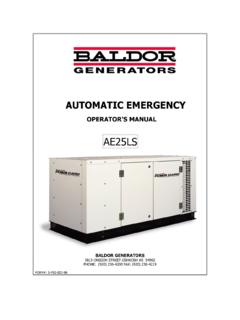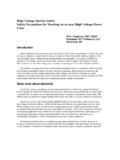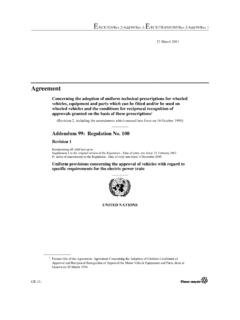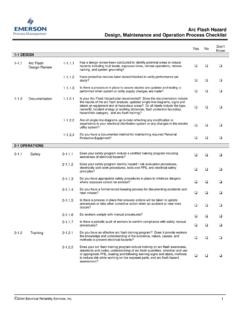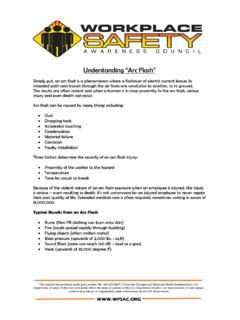Transcription of Working on Exposed Energized Parts
1 Working on Exposed Energized Parts . - App B Regulations (Standards - 29 CFR) - Table of Contents part Number: 1910 part Title: Occupational Safety and Health Standards Subpart: R Subpart Title: Special Industries Standard Number: App B Title: Working on Exposed Energized Parts . Appendix B to -- Working on Exposed Energized Parts I. Introduction Electric transmission and distribution line installations have been designed to meet National Electrical Safety Code (NESC), ANSI C2, requirements and to provide the level of line outage performance required by system reliability criteria. Transmission and distribution lines are also designed to withstand the maximum overvoltages expected to be impressed on the system. Such overvoltages can be caused by such conditions as switching surges, faults, or lightning. Insulator design and lengths and the clearances to structural Parts (which, for low voltage through extra-high voltage, or EHV, facilities, are generally based on the performance of the line as a result of contamination of the insulation or during storms) have, over the years, come closer to the minimum approach distances used by workers (which are generally based on non-storm conditions).
2 Thus, as minimum approach ( Working ) distances and structural distances (clearances) converge, it is increasingly important that basic considerations for establishing safe approach distances for performing work be understood by the designers and the operating and maintenance personnel involved. The information in this Appendix will assist employers in complying with the minimum approach distance requirements contained in paragraphs (l)(2) and (q)(3) of this section. The technical criteria and methodology presented herein is mandatory for employers using reduced minimum approach distances as permitted in Table R-7 and Table R-8. This Appendix is intended to provide essential background information and technical criteria for the development or modification, if possible, of the safe minimum approach distances for electric transmission and distribution live-line work. The development of these safe distances must be undertaken by persons knowledgeable in the techniques discussed in this appendix and competent in the field of electric transmission and distribution system design.
3 II. General A. Definitions The following definitions from (x) relate to work on or near transmission and distribution lines and equipment and the electrical hazards they present. Exposed . Not isolated or guarded. Guarded. Covered, fenced, enclosed, or otherwise protected, by means of suitable covers or casings, barrier rails or screens, mats, or platforms, designed to minimize the possibility, under normal conditions, of dangerous approach or accidental contact by persons or objects. NOTE: Wires which are insulated, but not otherwise protected, are not considered as guarded. Insulated. Separated from other conducting surfaces by a dielectric (including air space) offering a high resistance to the passage of current. NOTE: When any object is said to be insulated, it is understood to be insulated for the conditions to which it is normally subjected. Otherwise, it is, within the purpose of this section, uninsulated. B. Installations Energized at 50 to 300 Volts The hazards posed by installations Energized at 50 to 300 volts are the same as those found in many other workplaces.
4 That is not to say that there is no hazard, but the complexity of electrical protection required does not compare to that required for high voltage systems. The employee must avoid contact with the Exposed Parts , and the protective equipment used (such as rubber insulating gloves) must provide insulation for the voltages involved. C. Exposed Energized Parts Over 300 Volts AC Table R-6, Table R-7, and Table R-8 of provide safe approach and Working distances in the vicinity of Energized electric apparatus so that work can be done safely without risk of electrical flashover. The Working distances must withstand the maximum transient overvoltage that can reach the work site under the Working conditions and practices in use. Normal system design may provide or include a means to control transient overvoltages, or temporary devices may be employed to achieve the same result. The use of technically correct practices or procedures to control overvoltages (for example, portable gaps or preventing the automatic control from initiating breaker reclosing) enables line design and operation to be based on reduced transient overvoltage values.
5 Technical information for electrical systems indicates that current design provides for the following maximum transient overvoltage values (usually produced by switching surges): 362 kV and less -- per unit; 552 kV -- per unit; 800 kV -- per unit. Additional discussion of maximum transient overvoltages can be found in paragraph , later in this Appendix. III. Determination of the Electrical Component of Minimum Approach Distances A. Voltages of kV to kV For voltages of kV to kV, the electrical component of minimum approach distances is based on American National Standards Institute (ANSI)/American Institute of Electrical Engineers (AIEE) Standard , March 1943, Tables III and IV. (AIEE is the predecessor technical society to the Institute of Electrical and Electronic Engineers (IEEE).) These distances are calculated by the following formula: Equation (1) - For voltages of kV to kV (For Equation 1, Click Here) Where: D = Electrical component of the minimum approach distance in air in feet V(max) = Maximum rated line-to-ground rms voltage in kV pu = Maximum transient overvoltage factor in per unit Source: AIEE Standard No.
6 4, 1943. This formula has been used to generate Table 1. Table 1. - AC Energized Line-Work Phase-to-Ground Electrical Component of the Minimum Approach Distance - to kV _____ | Maximum anticipated | Phase to phase voltage per-unit |_____ transient overvoltage | | | | | 15,000 | 36,000 | 46,000 | 72,500 _____|_____|_____|_____|_____ | | | | | | | | _____|_____|_____|_____|_____ NOTE: The distances given (in feet) are for air as the insulating medium and provide no additional clearance for inadvertent movement. B. Voltages of kV to 800 kV For voltages of kV to 800 kV, the electrical component of minimum approach distances is based on ANSI/IEEE Standard 516-1987, "IEEE Guide for Maintenance Methods on Energized Power Lines." This standard gives the electrical component of the minimum approach distance based on power frequency rod-gap data, supplemented with transient overvoltage information and a saturation factor for high voltages.
7 The distances listed in ANSI/IEEE Standard 516 have been calculated according to the following formula: Equation (2) - For voltages of kV to 800 kV D = (C + a)pu V(MAX) Where: D = Electrical component of the minimum approach distance in air in feet C = to take care of correction factors associated with the variation of gap sparkover with voltage a = A factor relating to the saturation of air at voltages of 345 kV or higher pu = Maximum anticipated transient overvoltage, in per unit ( ) V(MAX) = Maximum rms system line-to-ground voltage in kilovolts - it should be the "actual" maximum, or the normal highest voltage for the range (for example, 10 percent above the nominal voltage) SOURCE: Formula developed from ANSI/IEEE Standard No. 516, 1987. This formula is used to calculate the electrical component of the minimum approach distances in air and is used in the development of Table 2 and Table 3. Table 2. - AC Energized Line-Work Phase-to-Ground Electrical Component of the Minimum Approach Distance - 121 to 242 kV _____ | Maximum anticipated | Phase to phase voltage per-unit |_____ transient overvoltage | | | | | 121,000 | 145,000 | 169,000 | 242,000 _____|_____|_____|_____|_____ | | | | | | | | | | | | | | | | | | | | | | | | | | | | | | | | | | | | | | | | | | | | | | | | _____|_____|_____|_____|_____ NOTE.
8 The distances given (in feet) are for air as the insulating medium and provide no additional clearance for inadvertent movement. Table 3. - AC Energized Line-Work Phase-to-Ground Electrical Component of the Minimum Approach Distance - 362 to 800 kv _____ | Maximum anticipated | Phase to phase voltage per-unit |_____ transient overvoltage | | | | 362,000 | 552,000 | 800,000 _____|_____|_____|_____ | | | | .. | | | .. | | | .. | | | .. | | | .. | | | | | | | | .. | | | .. | | | .. | | | .. | | .. | .. | | .. | .. | | .. |.
9 | | .. | .. | | .. | .. | | .. | .. _____|_____|_____|_____ NOTE: The distances given (in feet) are for air as the insulating medium and provide no additional clearance for inadvertent movement. C. Provisions for Inadvertent Movement The minimum approach distances ( Working distances) must include an "adder" to compensate for the inadvertent movement of the worker relative to an Energized part or the movement of the part relative to the worker. A certain allowance must be made to account for this possible inadvertent movement and to provide the worker with a comfortable and safe zone in which to work. A distance for inadvertent movement (called the "ergonomic component of the minimum approach distance") must be added to the electrical component to determine the total safe minimum approach distances used in live-line work. One approach that can be used to estimate the ergonomic component of the minimum approach distance is response time-distance analysis.
10 When this technique is used, the total response time to a hazardous incident is estimated and converted to distance traveled. For example, the driver of a car takes a given amount of time to respond to a "stimulus" and stop the vehicle. The elapsed time involved results in a distance being traveled before the car comes to a complete stop. This distance is dependent on the speed of the car at the time the stimulus appears. In the case of live-line work, the employee must first perceive that he or she is approaching the danger zone. Then, the worker responds to the danger and must decelerate and stop all motion toward the Energized part . During the time it takes to stop, a distance will have been traversed. It is this distance that must be added to the electrical component of the minimum approach distance to obtain the total safe minimum approach distance. At voltages below kV, the electrical component of the minimum approach distance is smaller than the ergonomic component.
